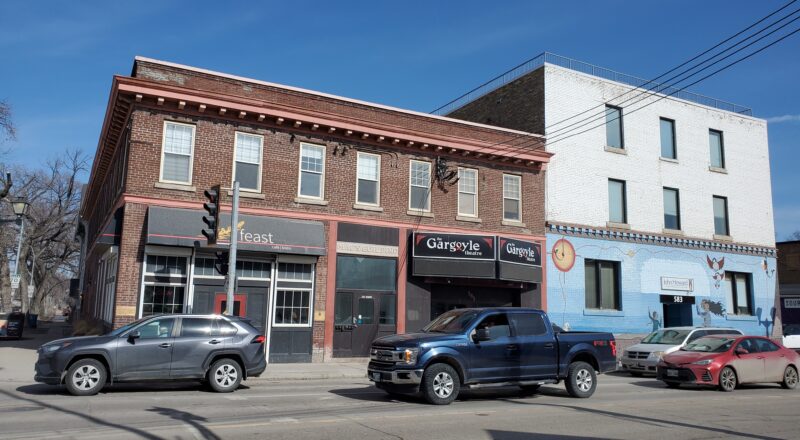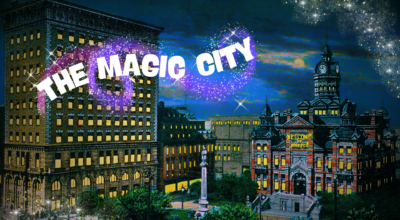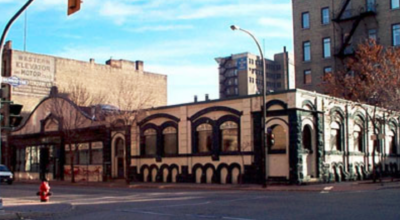
/ Blog
May 5, 2025
“Always a Good Show, All Ways”: The Legacy of 585-587 Ellice Avenue
When cinema first swept the world in the early 20th century, Winnipeg was one of many cities rife with neighbourhood theatres. Many businessmen jumped at the opportunity to profit from this accessible new form of entertainment. Going to the theatre was a cheap and easy way to see the world, pass some time, and bring excitement into your life.
Unfortunately, these small cinemas did not stand the test of time. Technological advancements made it possible to view films in your home, and multiplex theatre chains with better equipment and first-run films came into the frame. This was detrimental to most neighbourhood theatres, many of which could only play one film at a time and would only have access to second-run pictures. These historic buildings, which were designed to serve a specific purpose, would need to be greatly altered to avoid demolition.
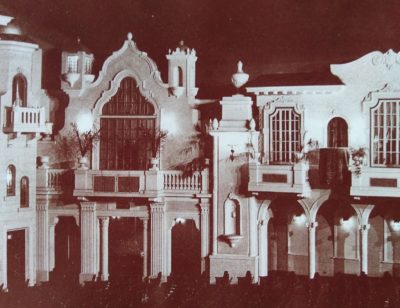
Original façades in the Uptown Theatre. Source: Heritage Winnipeg Resource Centre
Some of these theatres, such as the Roxy (385 Henderson Highway), the Uptown (394 Academy Road), and the Palace (501 Selkirk Avenue), were altered into department stores or bowling alleys. While this did preserve the buildings’ exterior facades, the interiors were gutted as there were no heritage bylaws yet in place to protect the character-defining elements.
Somehow, a small handful of neighbourhood theatres avoided the swing of the sledgehammer. One of these was the small but mighty Mac’s Theatre in the West End, a theatre that managed to change with the times while still honouring its dedication to entertainment.

A postcard with a view of the West End from the Merchant’s Bank building (371 Main Street), c. 1903-1906. Source: Martin Berman Postcard Collection, Public Domain.
The Early 20th Century: Mac’s Theatre
The block at 585-587 Ellice Avenue was built in 1912 and was designed by renowned Winnipeg Architect J.D. Atchison. It was built for Neil T. MacMillan, an Ontario-born Real Estate mogul and Businessman who later relocated to Florida. The building consisted of three parts: a few residential units, a main-floor retail space that started as a pharmacy, and a small neighbourhood movie theatre called Mac’s Theatre. From the years of 1921 to 1924, the building was owned by Union Bank, but was sold again when Union was acquired by the Royal Bank of Canada. The retail space remained a pharmacy until the 1990s, with a lunch counter and small store incorporated as well.
Mac’s Theatre caught up with the age of “talking pictures” in 1931 and was run by J.G. Christie from then until 1943. The theatre’s slogan was “Always – A Good Show – All Ways”. Sometime soon after, management was taken over by Allied Amusements, the theatre chain responsible for neighbourhood theatres across the city that included the Roxy and the Uptown Theatre. It remained this way until the mid-1960s.
The Late 20th Century: Cinema 3
Over the next few decades, each portion of the building was slowly acquired by the Holunga family. Nestor Holunga purchased Mac’s Theatre in 1966, and his family leased a section of the retail space for decades before fully purchasing the space in 1986.
At first, Holunga’s theatre showed a mix of foreign language films and mainstream films. In 1969, the theatre was renovated thanks to investments from various businessmen and was reopened as Cinema 3, playing only independent and foreign films.
For the next 30 years, Cinema 3 was Winnipeg’s go-to theatre for unique films, attracting many young audiences and becoming a cultural hub. Unfortunately, this chapter in the building’s life ended with the 20th century.
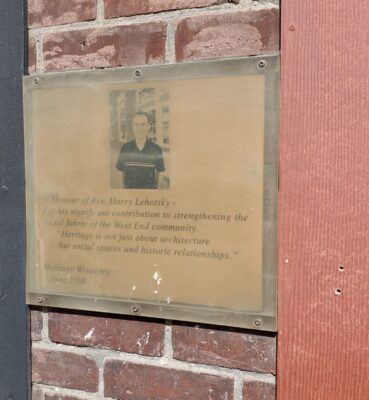
A plaque that was erected by Heritage Winnipeg in honour of the late Reverend Harry Lehotsky. Source: Heritage Winnipeg
The 21st Century: Old Building, New Life
In 2004, West End Reverend and community figure Harry Lehotsky announced that his foundation, New Life Ministries, would be purchasing the building at 585-587 Ellice Avenue. By 2005, the retail space had become the community-focused Ellice Café, the residential units became low-income housing, and Cinema 3 was fixed up to be used for private bookings and community events. Lehotsky passed away only a year later, and his legacy led to the announcement of the Reverend Harry Lehotsky Award for Community Activism by the Manitoba Attorney General.
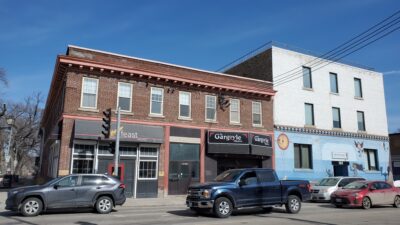
585-587 Ellice Avenue. Source: Heritage Winnipeg
The Ellice Theatre & Café closed in 2012. In 2015, the retail portion of the building became Feast Café Bistro, an indigenous-owned restaurant with a strong community focus, created by celebrated chef Christa Bruneau-Guenther. Feast is still open 10 years on and continues to offer services such as meal vouchers to support the West End community.
For several years, the theatre was owned by Manitoba-born actor Adam Beach, who used the space for his Film Institute. The institute relocated and later closed permanently due to the COVID-19 pandemic.
Once again, the theatre portion of this historic building was left empty and was in need of a sympathetic soul to give it new life. As fate would have it, one local novelist just so happened to be making his return to the world of live performance.
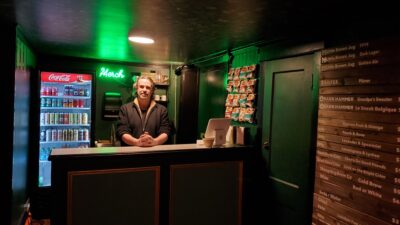
Andrew Davidson, current owner of the Gargoyle Theatre, standing at the concession stand in the building. Source: Heritage Winnipeg
Enter Davidson, Pursued by a Dream
Earlier this year, Heritage Winnipeg Staff visited the theatre space at 585-587 Ellice Avenue to speak with its current owner, Andrew Davidson.
Andrew Davidson has lived in Winnipeg for the last 20 years and was born and raised in Pinawa. He is best known as the author of a novel with the same name as his theatre, “The Gargoyle”, which was published in 2008.
“In about 2017, 2018, I started thinking about wanting to buy a theatre with the intent of that theatre being used to support early career creators. The reason for that was that I, at that time, was writing a lot of theatre pieces – musicals and plays – and discovering how very, very difficult it is to find development space for people early in their career as a theatre creator. From my own frustration of not being able to find space and support, I sort of thought, ‘well, if I can’t get the mountain to come to me, I’ll build the mountain to which I can visit,’ which in this case was the theatre.”
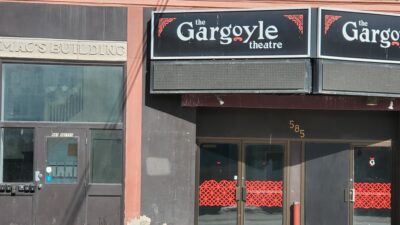
The front door of the Gargoyle Theatre. Source: Heritage Winnipeg
After searching the city for a space that would accommodate his needs, Davidson’s property agent approached him with a theatre rental, the former Mac’s theatre at 585-597 Ellice Avenue.
“The challenge at that point was that with the amount of renovation the space would need, I certainly couldn’t put that kind of money into somebody else’s building, so I entered into negotiations with the owners of the building at that point and ended up buying the building, at which point I felt comfortable putting my time, money and energy into renovating the space that we’re sitting in now.”
Breaking the Fourth Wall
Because of its various reincarnations throughout its life and its original intention as a movie theatre, the space was lacking in a few key components needed for live theatre, including backstage space. For Davidson, this was a welcome challenge.
“Philosophically and practically, my favourite type of theatre space is one where there’s very little division between the artist and the audience. At one point, I considered putting a full curtain across the front of the stage as a way to create a backstage area, dividing the audience and the artist, but I really did not want that.”
Instead, Davidson chose to remove the back third of the seats, sacrificing a chunk of the capacity to create an open “mingling area.”
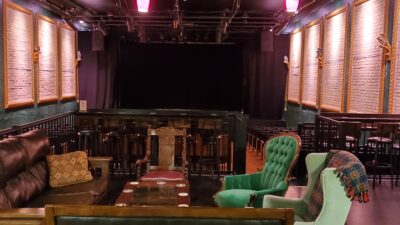
The “Mingling Area” of the Gargoyle Theatre. Source: Heritage Winnipeg
“We rebuilt the previous stage because it had seen better days, and we built this mingling area out of the previous stage, which philosophically is quite nice because then, when people hang out before and after the shows, they’re actually hanging out on the old stage. I really encourage the creators, whether they be the writers, directors, or the actors themselves, to interact with the audience before and after.”
“I want people to not only see a show but feel a part of a little community, and that community, for me, is in the mandate of the theatre itself, which is to support new works – new original theatrical works.”
After purchasing the building in 2019, Davidson’s original intention was to open the theatre in the fall of 2020. These plans were postponed by the COVID-19 pandemic, which gave Davidson an extra two years to create the space he dreamed of.
“I love the space now, it’s different than what I had originally envisioned, but it is a very nice feeling to look around the space and remember what it was, and to know that a lot of work went into making it what it is now. Almost every inch of this place has been renovated in one way or another since the purchase in 2019.”
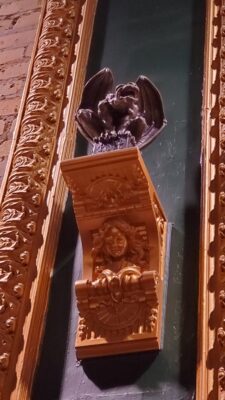
A Gargoyle statue on a pedestal on the wall of the theatre. Source: Heritage Winnipeg
“Always in the Process of Becoming”
It’s evidently clear from the naming of both his book and his theatre space that Davidson is partial to the term “Gargoyle.”
“…it’s this kind of undefinable beast. It’s halfway between two things; it’s like a human form melded with, let’s say, a lion, and they’re chimeras. They’re beasts of multiple provenance, basically, and it never feels as though its actually become what its meant to be, but its always in the process of becoming, which, for a theatre such as mine, which is a workshop theatre, I really like it when we’re presenting a new work and it is changing and mutating right up until the premiere. If they change things during the run, I’m even happier, because it’s serving its purpose. It’s about the birth of new art as opposed to taking existing plays and musicals and reinterpreting them, which is beautiful and wonderful, but we have multiple theatres in Winnipeg that really service that very, very well.”
The gothic themes of the gargoyle are also reflected in the decor; rich colours, gargoyle statues on wall-mounted pedestals, black curtains, etc.
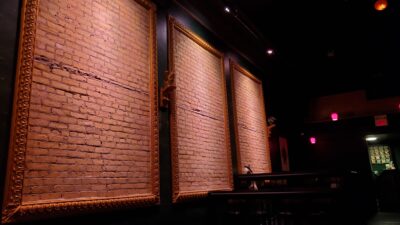
The exposed brick of the building is showcased in gold-painted frames. Source: Heritage Winnipeg
Another eye-catching component of the decor is the large frames along the walls that showcase the exposed brick that lives beneath. The original bricks had been covered by an inch of plaster when Davidson took over.
“That also fits into the philosophy of the space and the aesthetic of the space, it’s the artwork of the building itself. I’m not trying to hide things here. I’m trying to expose them. I like to expose the workings of the theatre itself and expose the workings of the building.”
Thanks to brilliant lighting techniques, these bricks get to be a part of the artwork of the theatre.
“We rebuilt the entire light grid with the wonderful Scott Henderson, who is one of Winnipeg’s great theatre lighting people, and he installed these LED lights over all of these framed exposed bricks. It’s really beautiful when we light the brick in different ways depending on the event.”
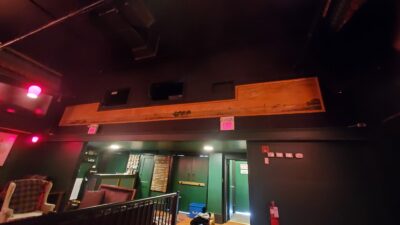
The back wall of the Gargoyle Theatre, which had been hiding a long mural. Source: Heritage Winnipeg
Hidden History
During the renovation of the space, Davidson discovered that the building had been hiding an interesting secret. Beneath the barker board and plaster of the back wall, they found a scenic mural that had been painted to fit the shape of the wall. Shocked by this discovery, Davidson turned to West End history buff Christian Cassidy (West End Dumplings) for more information, and Cassidy recognized the style.
“He sent me photos from another building here in town that had exactly the same style, exactly the same colours, for sure it is the same artist, and it was a mural from around 1912. So, this has been here since the start of the building. It would have been put on the walls in 1912 when the building was being built, and it was hidden inside a wall for how long? I don’t know, but it’s now available for the public to see again.”
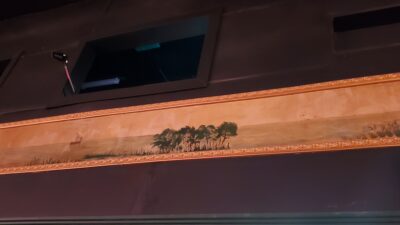
Details on the Gargoyle’s mural. Source: Heritage Winnipeg
The aforementioned building was Petursson House at 616 Alverstone Street, which had been constructed in 1914. The owner had recruited the help of arts conservation students from the University of Manitoba, who credited the mural to Icelandic artist Fridrik Sveinsson, the same artist whose stained glass window designs can be found at the First Unitarian Universalist Church of Winnipeg.
Today, the mural in the gargoyle has been incorporated into the design and has been given an appropriate frame.
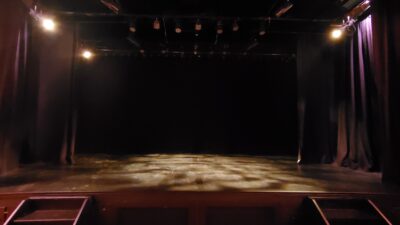
The stage at the Gargoyle Theatre. Source: Heritage Winnipeg
Going “Off-Book”
While Davidson’s big claim to fame is his novel, he has always had a special connection to the world of theatre.
“I started at the Black Hole Theatre at the University of Manitoba in the late 80s, in my first years of university. I spent a couple of years in University theatre, both at the University of Manitoba and the University of British Columbia, but then I moved away from it as a practitioner and became an audience member and admirer, and a lover of it for many many years.”
About a decade ago, Davidson began reconnecting with the theatre world through playwriting.
“Having been away from theatre for all of those years, as a practitioner, to be someone who made a living as an artist, but not in that discipline, it’s kind of a blessing and a curse. I was able to come into this endeavor and not know what all the established norms are. The cursed part of it is that I made tons and tons of mistakes from figuring out how its going to work for me as we go along, but the blessing is to be able to go ‘well, I don’t have to do it exactly the same way as other people are doing it.’”
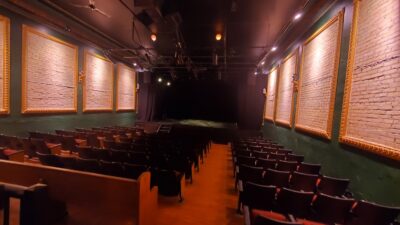
The seating at the Gargoyle Theatre. Source: Heritage Winnipeg
A Different Kind of Theatre
On the surface, the Gargoyle may seem like any other performance space, but its purpose and mandate differ greatly from other venues. The process starts with a Casual Pitch-Week, where any local creator with a theatrical project can come in and chat with Davidson about their work.
“For me, there are lots of things involved with this conversation. It’s not just a straight pitch of ‘tell me the one thing you’re working on’. I want to get to know the person and see what they’re working on. Very often they’re talking about a specific project that is the thing they’re working on right now, but I know very quickly that it’s maybe not the project for this space, for any number of reasons… but I really like them as people, and I like their art, and I like the way that they’ve written the project, even if that’s not the project for me, and then I can very sincerely say, ‘this isn’t the project for me, but I see that your writing is great. Please, when you have something else, come back.’ Very often I’ll say, ‘yeah, this one’s not necessarily a good fit, are you working on anything else?’ and they’ll tell me about the second thing they have on the go, and the third thing they have on the go, and it’s happened a number of times where somebody has come in and said ‘here’s what I want to talk to you about’, and that’s not necessarily the fit for me, but the third thing we talk about, I go, ‘wow, that’s super interesting.’”
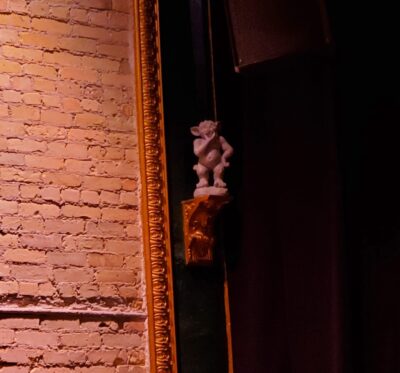
A cheeky gargoyle statue on a pedastal in the Gargoyle Theatre. Source: Heritage Winnipeg
“It’s also a matter of listening to each other sincerely and seeing if I’m excited about the project, what way I can support it. At the beginning, I was really focused on just having productions happen here. That’s not necessarily the case now. Now, we have public play readings, which I’m very happy to put on so that people can get feedback from the audience. I’m really interested in giving worthy projects development space to happen. When I’m talking to people, there are really no hard and fast rules. It’s a case-by-case situation, and I’m really happy to explore that when I have my casual pitch week.”
For Davidson, this process is a two-way street that allows him to make his own connections in the theatre world and to stay up-to-date with emerging artists.
“It’s a really nice opportunity for me to get to know who’s doing what in the community. The other great thing about this, for me, is that I’m talking to people about what they’re doing, sometimes I’m able to say, ‘you know, that’s not a fit for me, but this other theatre company is doing something very similar. Can I introduce the two of you and see if there’s a fit there?’ and that’s a really nice part of that pitch week as well.”
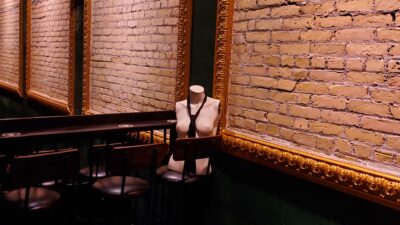
A headless mannequin sports a tie in the Gargoyle theatre. Source: Heritage Winnipeg
Davidson isn’t the only one who gets to make connections through the theatre’s process. For many early-career artists, it’s an ideal place to meet people who share their passion for the arts.
“[The theatre’s] philosophy really is encapsulated in the fact that I took out a third of the seating to go, ‘here’s where people will mingle.’ I want people to be able to genuinely connect, as people and over the art.”
The Gargoyle’s intentions expand beyond the walls of the theatre itself; Davidson wants it to play a role in the growth and continued development of the theatre and performance industry in Winnipeg.
“In my dream of dreams, let’s say 20 years from now, I’d love for Winnipeg to be punching above its weight as a city for playwrights and creators – as it is already, we are a great theatre city – but for a lot of those people to say ‘the first thing I ever did was at the Gargoyle Theatre and that’s a good memory.’ That’s what I would like for them to take away.”
“We’re not big. We don’t have a long history, but we’re very sincere in what we’re doing, and we’re giving a space in the way that we can, in a way that if we weren’t here, that opportunity wouldn’t exist, and we’re just glad to be able to offer that.”

Photo on Ellice Street. Source: Heritage Winnipeg
The West End’s Hearty Heritage
Winnipeg’s West End tends to be overlooked by those outside of it, but its businesses and organizations play a large role in the city’s cultural landscape. It’s home to the West End Cultural Centre, one of our city’s greatest examples of adaptive reuse. The people who reside in the neighbourhood come from across the world and various walks of life. Small businesses like Feast Café and Bistro and Eadha Bakery Worker Co-op are the creators of both delicious eats and supportive, empathetic community spaces. The Gargoyle Theatre helps emerging artists bring their work to life without financial barriers. These businesses were all created by people who, like Davidson, saw a specific need in their communities and decided to be the ones to do something about it. They took what was already there and built something new out of it, rather than demolishing and starting from scratch. This is the type of restoration work that comes from the heart and extends throughout the community, creating new stories for our buildings to tell!
Thank you to Andrew Davidson for the interview and to Christian Cassidy for providing information on the murals.
Check out the upcoming production at the Gargoyle Theatre, “How They’ll Tell It”, a new play by local playwright Sophie Guillas, directed by Cali Sproule.
Sources:
“About the Theatre”, The Gargoyle Theatre website
“A Faith-Lift”, Alison Mayes for Winnipeg Free Press Sitelines, October 23rd, 2004.
“Lehotky’s Passion will Survive”, Alexandra Paul for Winnipeg Free Press, May 27th, 2006.
“585 Ellice Avenue – Mac’s Building”, Christian Cassidy, West End Dumplings, June 30th, 2024.
Silver Screens on the Prairie, Russ Gourluck, Great Plains Publications, 2012





